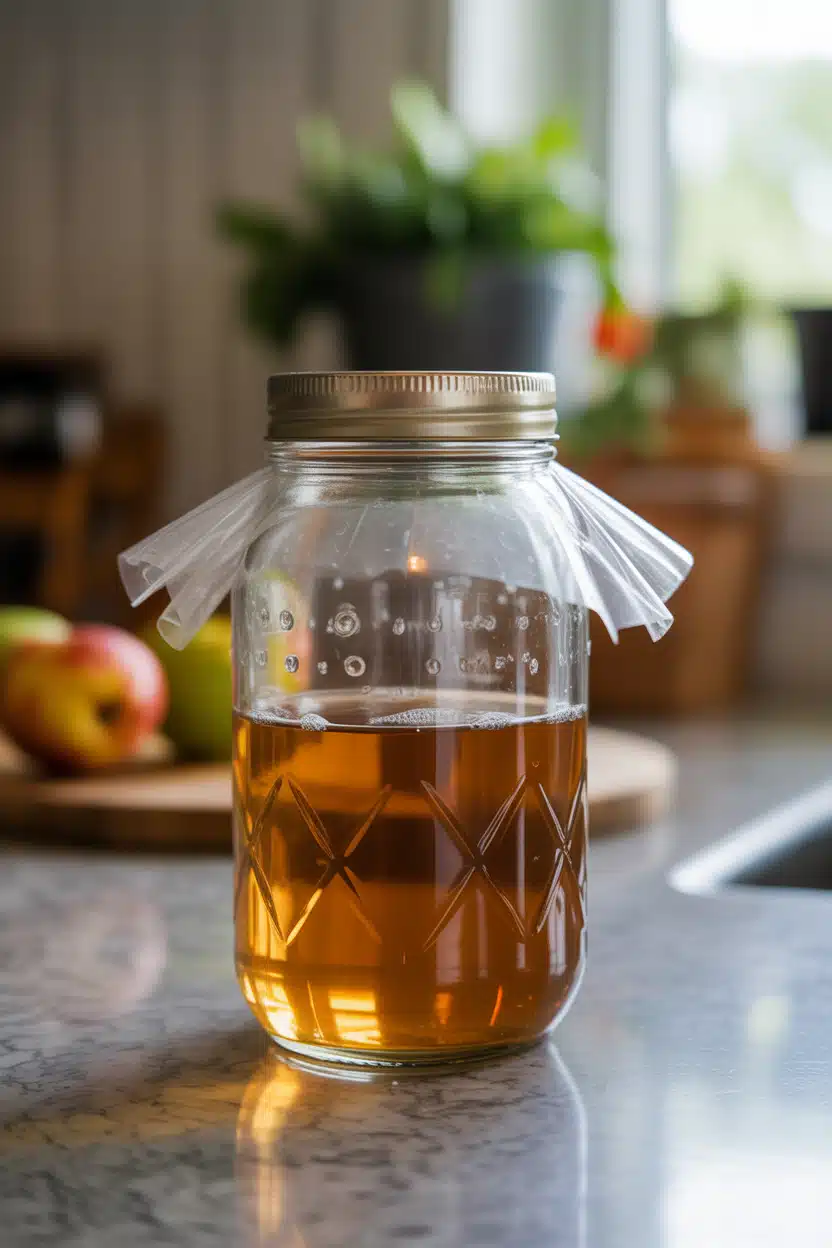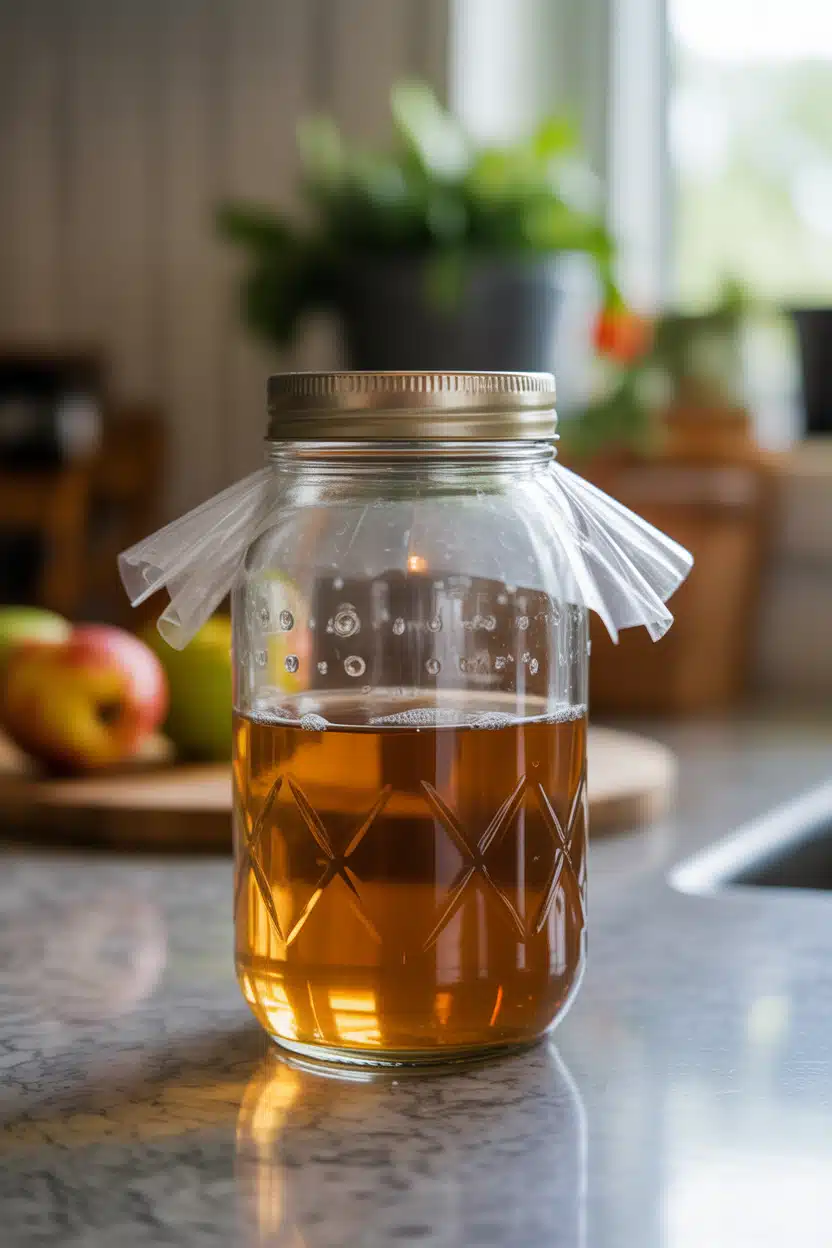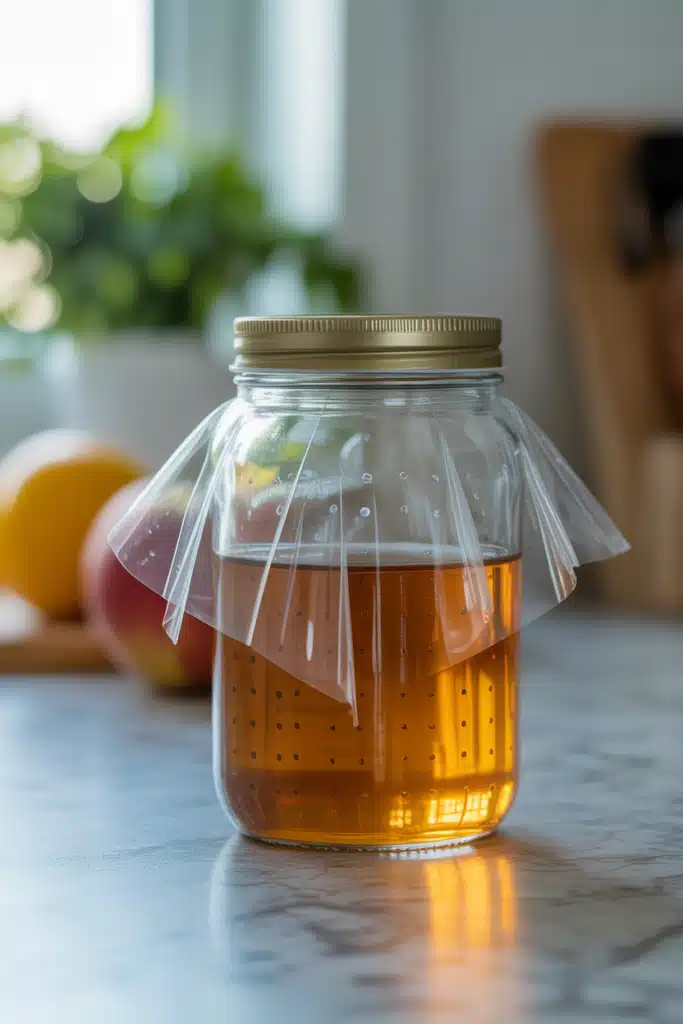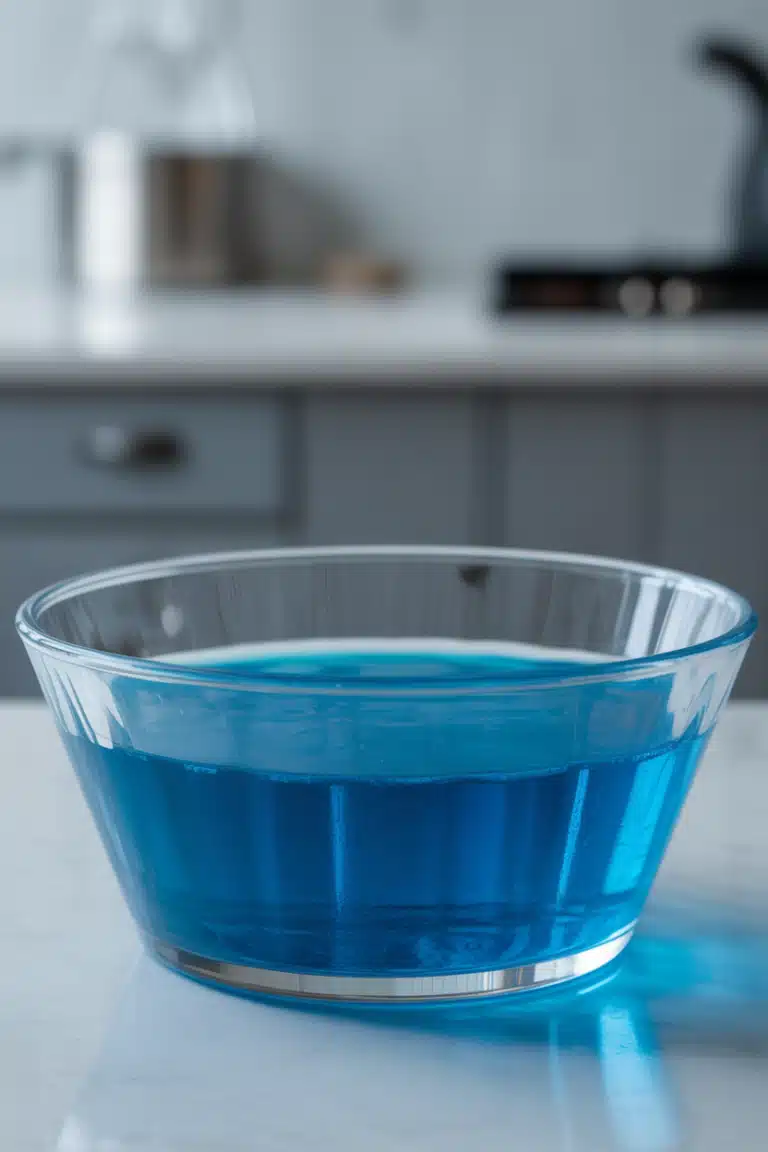Follow Me On Social Media!
Apple Cider Vinegar Gnat Trap Recipe That Actually Works

Last updated on August 28, 2025
Apple cider vinegar gnat trap recipe is the easiest way to stop tiny pests from buzzing around your kitchen or plants. Gnats can quickly become a nuisance, especially when they gather near fruit bowls, houseplants, or drains. The good news? With just vinegar, sugar, and a few everyday supplies, you can build a natural, chemical-free trap in minutes. In this guide, I’ll share step-by-step instructions, variations that make traps more powerful, troubleshooting tips, and answers to common questions so you’ll finally have a gnat-free home.
Key Takeaways: Apple Cider Vinegar Gnat Trap Recipe
- Apple cider vinegar is the best base because its sweet, fermented aroma mimics rotting fruit.
- Add sugar or fruit pieces to strengthen the lure if gnats ignore the trap.
- Seal with plastic wrap and poke holes so gnats can enter but not escape.
- One drop of dish soap helps sink gnats by breaking surface tension.
- Replace traps every 24–48 hours for consistent results.
- If it isn’t working, adjust hole size, vinegar freshness, or sugar ratio.
Jump To :
How do you make an apple cider vinegar trap for gnats?
The simplest apple cider vinegar gnat trap recipe uses just a jar, vinegar, and plastic wrap. Gnats are naturally drawn to the sweet, fermented smell of cider vinegar. By turning that attraction into a one-way entrance, you can capture dozens overnight without harmful sprays or chemicals.
Step-by-Step Instructions
- Choose a small container. A glass jar, mug, or shallow bowl works.
- Pour in vinegar. Add about ½ cup of apple cider vinegar.
- Boost the scent. Stir in 1 teaspoon of sugar or drop in a slice of ripe fruit.
- Seal the top. Cover tightly with plastic wrap and secure with a rubber band.
- Poke small holes. Use a toothpick to make holes just large enough for gnats to crawl in.
- Optional upgrade. Add a drop of dish soap. This breaks surface tension so gnats sink instead of floating.
Why This Works
Apple cider vinegar contains natural sugars and acetic acid. Both mimic the smell of fermenting fruit, which is irresistible to gnats. Once they crawl inside, they can’t find their way back out, and the dish soap ensures they drown quickly.
Placement Tips
Set the trap near sinks, houseplants, fruit baskets, or garbage bins—anywhere you notice swarms. For heavy infestations, place multiple traps around the room.
This easy homemade gnat trap recipe not only saves money but also keeps your kitchen chemical-free. If you’re interested in other ways apple cider vinegar supports a healthier home, you might also want to read our apple cider vinegar drink for gout article. That guide explores how the same pantry staple helps with joint health, linking back to its role in natural wellness and even our apple cider vinegar weight loss recipe pillar.
Why is my vinegar gnat trap not working?
Sometimes a carefully prepared apple cider vinegar gnat trap recipe doesn’t catch a single insect. It’s frustrating, but there are clear reasons why traps fail. Understanding these mistakes will help you reset your approach and finally see results.
Common Reasons Your Trap Fails
- Vinegar is too old or weak.
If your vinegar has been sitting open for months, the scent may have faded. Gnats need a strong, fresh aroma to be lured in. Always use recently opened apple cider vinegar or boost old vinegar with sugar. - Holes are the wrong size.
If the holes in the plastic wrap are too small, gnats can’t enter. If they’re too big, gnats fly in and escape again. Aim for tiny punctures just wide enough for gnats to crawl through. - No surface tension breaker.
Without dish soap, gnats may land on the vinegar surface and fly away. One drop of soap ensures they sink quickly and stay trapped. - Wrong placement.
Setting traps far from gnat hotspots reduces effectiveness. Always place them near drains, fruit bowls, or potted plants where gnats gather most.
Easy Fixes to Try
- Use ½ cup of fresh apple cider vinegar mixed with 1 teaspoon sugar.
- Add 1 drop of dish soap and stir.
- Cover tightly with plastic wrap and poke small holes.
- Refresh the trap every 24–48 hours.
With these adjustments, your trap should start filling up within a few hours.
Why It Matters
Gnats reproduce quickly, laying eggs in soil, fruit, or drains. If your trap isn’t catching them, the population can multiply overnight. By correcting small errors, you’ll not only trap existing gnats but also prevent future swarms.
Curious about the wellness side of vinegar? Our apple cider vinegar drink for gout article explains how cider vinegar supports joint health, connecting directly back to our apple cider vinegar weight loss recipe . This shows how vinegar can be both a natural pest solution and a powerful health tonic.
Is apple cider vinegar or vinegar better for fly traps?
When it comes to building an effective fly trap, not all vinegars perform the same. Many people wonder if plain white vinegar works as well as the classic apple cider vinegar gnat trap recipe. The answer lies in the scent.
Apple Cider Vinegar vs. White Vinegar
- Apple cider vinegar: Made from fermented apples, it has natural sugars and a fruity aroma that gnats and fruit flies can’t resist.
- White vinegar: Strongly acidic but lacks the sweet notes. It repels gnats more than it attracts them.
This is why most homemade gnat trap recipes call for apple cider vinegar. Its smell mimics decaying fruit, which is a gnat’s natural breeding ground.
Boosting the Recipe
If you only have white vinegar, you can adapt the trap. Add 1 teaspoon sugar and a piece of ripe fruit to create a sweeter aroma. But whenever possible, stick to cider vinegar for guaranteed success.
Here’s a quick comparison:
| Vinegar Type | Attraction Level | Best Use in Traps |
|---|---|---|
| Apple Cider Vinegar | ⭐⭐⭐⭐⭐ Strong | Best for gnats & fruit flies |
| White Vinegar | ⭐⭐ Weak | Works with added sugar/fruit |
Why Apple Cider Vinegar Wins
The apple cider vinegar gnat trap recipe with vinegar and sugar consistently outperforms other methods because it balances acidity with natural sweetness. This irresistible combination lures gnats into the trap and ensures they don’t escape.
How long does it take vinegar to kill gnats?
A well-made apple cider vinegar gnat trap recipe starts working within hours, but the time it takes to kill gnats depends on how many are present and how the trap is set up. Most people notice results overnight, with dozens of gnats caught by morning.
Expected Timeline
- Within 2–4 hours: Gnats begin circling and entering the trap.
- By the first night: Many gnats drown due to dish soap breaking surface tension.
- 24–48 hours: Traps capture the majority of visible gnats.
- Ongoing: Refresh the trap every two days until no gnats remain.
Adding sugar or fresh fruit accelerates the process, making the vinegar gnat trap recipe even more effective.
Why Vinegar Works Quickly
Apple cider vinegar contains acetic acid and natural sugars, both of which mimic the smell of decomposing fruit. Gnats seek out this scent instinctively. Once inside the trap, the soap ensures they cannot escape. The U.S. Environmental Protection Agency (EPA) even recommends vinegar-based solutions as safe, non-toxic pest control for indoor environments (EPA.gov) — proof that this homemade remedy is both effective and safe for families.
Real Experience
When I first tried the apple cider vinegar gnat trap recipe with fresh fruit, I placed a jar near my herb plants. By morning, over twenty gnats were floating in the vinegar. It was shocking but satisfying. Replacing the trap every two days completely cleared the infestation within a week.
Health & Home Connection
Just as vinegar works fast against gnats, it also shows benefits in human health. Our apple cider vinegar drink for gout cluster explains how cider vinegar supports joint comfort. That connects directly back to the apple cider vinegar weight loss recipe pillar, proving how one ingredient supports both pest control and wellness.
For deeper insight into vinegar itself, you can also read more about its history and properties on Wikipedia: Vinegar.

How to get rid of gnats overnight?
If you want fast results, nothing works better than a tried-and-true apple cider vinegar gnat trap recipe. Gnats are drawn to sweet, fermenting scents, and apple cider vinegar delivers exactly that. By preparing several traps and placing them strategically, you can noticeably reduce a swarm in just one night.
Step 1: Prepare Multiple Traps
Set up at least three versions of the apple cider vinegar gnat trap recipe. Use small jars or cups with vinegar, sugar, and one drop of dish soap. The more traps you deploy, the more gnats you’ll capture while you sleep.
Step 2: Target Hotspots
Place traps near:
- Houseplants where moist soil attracts gnats.
- Fruit bowls with ripe bananas or apples.
- Sink drains that hold organic residue.
Gnats naturally gather in these places, so positioning your vinegar gnat trap recipe here ensures quick results.
Step 3: Refresh and Repeat
Check your traps in the morning. If you still see activity, replace the vinegar mixture with a fresh apple cider vinegar gnat trap recipe with vinegar and sugar. Within 48 hours, you should notice the infestation shrinking dramatically.
Why Overnight Results Happen
Gnats are most active at dusk and in the evening. That’s why an apple cider vinegar gnat trap recipe with fresh vinegar works best when left out overnight. The scent intensifies as the vinegar evaporates slightly, luring gnats to their end.
Extra Tip for Stubborn Infestations
Combine your traps with preventative cleaning. Wipe counters, empty garbage bins, and avoid leaving damp dishcloths overnight. The cleaner the environment, the more effective your traps.
This same vinegar also doubles as a wellness aid. For example, our apple cider vinegar drink for gout cluster explains how vinegar supports joint health. That resource connects directly natural pest control.
For additional confirmation, the Centers for Disease Control and Prevention (CDC) outlines how controlling fly breeding sites combined with safe traps is one of the fastest ways to reduce pests indoors.
What are the four ingredient fly traps?
The most reliable method for catching gnats is the four ingredient apple cider vinegar gnat trap recipe. By using vinegar, sugar, dish soap, and plastic wrap together, you create a highly effective trap that works fast and keeps gnats from escaping.
The Four Key Ingredients
| Ingredient | Purpose |
|---|---|
| Apple Cider Vinegar | Main attractant – mimics fermenting fruit |
| Sugar | Boosts sweetness to lure more gnats |
| Dish Soap | Breaks surface tension so gnats sink immediately |
| Plastic Wrap | Creates a one-way entry with small holes |
This homemade gnat trap recipe balances attraction and containment, making it much more effective than vinegar alone.
How to Prepare the Four Ingredient Trap
- Pour ½ cup of apple cider vinegar into a small jar or cup.
- Stir in 1 teaspoon of sugar to intensify the scent.
- Add one drop of dish soap to break surface tension.
- Cover the jar with plastic wrap and poke small holes with a toothpick.
Why Four Ingredients Work Best
A plain vinegar trap will attract gnats, but the apple cider vinegar gnat trap recipe with sugar and soap captures more. The vinegar lures, the sugar strengthens the aroma, the soap prevents escape, and the plastic wrap seals the deal. Together, these four simple ingredients form a foolproof trap that can clear infestations in just a couple of nights.
Pro Tip
For the fastest results, prepare multiple jars of the apple cider vinegar gnat trap recipe with fresh vinegar and place them near sinks, fruit bowls, and houseplants. Refresh every 48 hours to maintain maximum effectiveness.
Just like this recipe combines four simple ingredients for quick pest control, our apple cider vinegar drink for gout combines vinegar with water to support natural health. That article links back to our apple cider vinegar weight loss recipe , highlighting vinegar’s many roles in both wellness and home care.
For scientific confirmation, the United States Department of Agriculture (USDA) notes that fruit flies and gnats are strongly attracted to fermentation compounds — the exact compounds found in cider vinegar.

Apple Cider Vinegar Gnat Trap Recipe
Ingredients
Equipment
Method
- Pour ½ cup of apple cider vinegar into a small jar or bowl.
- Stir in 1 teaspoon of sugar to make the trap more attractive.
- Add 1 drop of dish soap to break surface tension so gnats sink.
- Cover the jar with plastic wrap and secure it with a rubber band.
- Poke 5–6 small holes in the wrap with a toothpick.
- Place the trap near sinks, fruit bowls, or houseplants.
- Refresh the mixture every 24–48 hours until gnats disappear.
Nutrition
Notes
Tried this recipe?
Let us know how it was!FAQ – Apple Cider Vinegar Gnat Trap Recipe
How do you make an apple cider vinegar trap for gnats?
To make a simple apple cider vinegar gnat trap recipe, pour ½ cup of apple cider vinegar into a jar, add one teaspoon of sugar, and stir. Drop in one small squirt of dish soap to break the surface tension. Cover the jar with plastic wrap, secure it with a rubber band, and poke several tiny holes. The sweet scent of vinegar lures gnats inside, while the soap makes sure they sink. Place traps near plants, sinks, or fruit bowls for quick results.
Why is my vinegar gnat trap not working?
If your vinegar gnat trap recipe isn’t catching gnats, the most common issues are stale vinegar, incorrect hole size, or lack of dish soap. Fresh vinegar has a stronger scent that attracts more gnats. Holes that are too big let gnats escape, while too small prevents them from entering. Dish soap is essential because it keeps gnats from floating on the surface. Try using fresh vinegar, add sugar for extra sweetness, and place traps near gnat hotspots like drains or houseplants.
Is apple cider vinegar or vinegar better for fly traps?
An apple cider vinegar gnat trap recipe works better than plain vinegar traps because apple cider vinegar has a natural fruity sweetness that mimics rotting fruit. White vinegar is highly acidic, but it does not have the same sugary aroma that gnats and fruit flies love. If apple cider vinegar isn’t available, you can adapt white vinegar traps by adding sugar and a piece of ripe fruit. Still, cider vinegar remains the best option for consistent results in homemade fly and gnat traps.
How long does it take vinegar to kill gnats?
A properly set apple cider vinegar gnat trap recipe starts working within hours. Most people notice gnats circling the jar almost immediately, and by the first night, several are usually caught. The dish soap in the recipe ensures gnats drown quickly once they touch the vinegar. In 24–48 hours, the majority of visible gnats are gone. To completely break the breeding cycle, refresh the trap every couple of days and keep multiple jars placed near problem areas until no gnats remain.
How to get rid of gnats overnight?
To eliminate gnats overnight, prepare multiple jars of the apple cider vinegar gnat trap recipe with vinegar and sugar and set them around hotspots like sinks, garbage bins, and fruit baskets. The strong scent of cider vinegar draws gnats in while dish soap ensures they drown quickly. For best results, combine the traps with good cleaning practices — wipe down counters, empty trash, and avoid leaving damp cloths overnight. By morning, you’ll find dozens of gnats caught in your jars, often reducing infestations dramatically.
What are the four ingredient fly traps?
The most effective four ingredient apple cider vinegar gnat trap recipe uses apple cider vinegar, sugar, dish soap, and plastic wrap. The vinegar provides the main lure, sugar strengthens the scent, dish soap breaks surface tension so gnats drown, and plastic wrap creates a one-way entry. Together, these ingredients make a simple but powerful fly trap. Place several around your home, refresh them every two days, and you’ll notice a sharp drop in gnats and fruit flies within a week.
Final Thoughts on the Apple Cider Vinegar Gnat Trap Recipe
The apple cider vinegar gnat trap recipe remains one of the easiest, cheapest, and most effective ways to deal with gnats indoors. With only a few pantry staples—vinegar, sugar, dish soap, and plastic wrap—you can protect your kitchen, houseplants, and drains from annoying infestations.

Why This Recipe Works So Well
Gnats are instinctively drawn to the scent of fermentation. Apple cider vinegar mimics rotting fruit, sugar intensifies the lure, dish soap ensures they sink, and plastic wrap prevents escape. Together, these four ingredients make a homemade gnat trap recipe that consistently delivers results.
Real Experience
One of our community members, Sophie, shared how she battled gnats swarming her fruit basket. After setting out an apple cider vinegar gnat trap recipe with fresh vinegar and sugar, she caught over thirty gnats the very first night. Within three days of refreshing her traps, the problem was completely gone—without using sprays or chemicals.
Beyond Pest Control
What makes vinegar so unique is its versatility. In this article, we’ve focused on its role in natural pest management. But vinegar also plays a huge part in health remedies. Our apple cider vinegar drink for gout cluster shows how vinegar supports joint comfort and wellness, while the apple cider vinegar weight loss recipe pillar explores how it can be included in drinks for metabolism support. From wellness to home care, vinegar is one of the most adaptable ingredients you can use.
Final Note
If you’re struggling with gnats, start with this apple cider vinegar gnat trap recipe tonight. Place a few jars around your problem areas, refresh them every two days, and keep your kitchen clean. Within a week, you’ll enjoy a calmer, gnat-free home—proof that sometimes the simplest solutions really are the most powerful.









